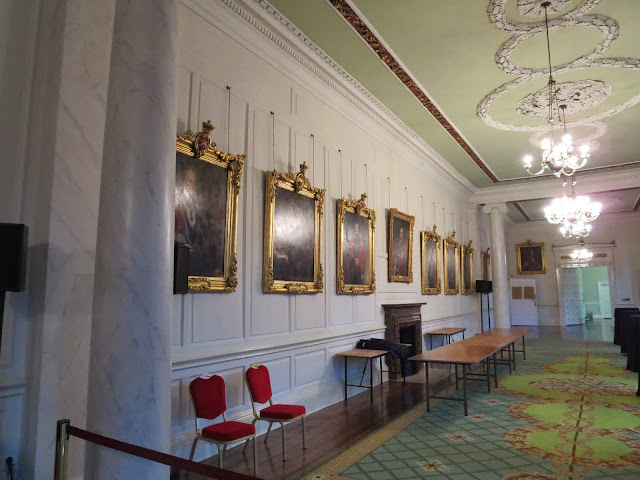Before I start with my jouney today, I had a journey to the hospital last night with one of our students that fell off her horse. Three of the riders ended up in the hospital from the horses that had gotten spooked. I am in the medical field so I am always curious as to how things are handled in different countries. By the time midnight and onto early hours of the morning, the halls were stacked on both sides with beds that touched head to foot. We were stacked and packed in.
Here in Ireland they don't like plastic. In the hospital they use pressed cardboard (like we use in packing products) for bedpans and urinals. I am glad not to have a heavy person using it on my watch.
On to Dublin and Dublin Castle . It was first a fortification established by King John of England in 1204. But in 1684 following the great fire it became a palace rather than a fortress.
Courtyard

Battleaxe Landing
Queens bedroom
Drawing Room above and below. The mirrors below are to make sure your skirts and petticoats were proper. Waterford glass pieces.
The Throne room
Reception room
Above is the Picture Gallery of protraits of 13 to 19th century
St Patrick' Hall. Here is where the President of Ireland was inagurated.
The ceilings of St Patrick's Hall.
The undercroft.
Here you can see the wall and then look in the picture to see the same wall.
Looking at one to the enterence of the castle. Leaving Dublin.
For more description on Dublin Castle, you might want to view my entry in 2011.
Lough Gur is an idyllic area with ancient stone formations 13 miles south east of Limerick.
Nearby is the largest Grange circle in Ireland comprised of 113 large standing stones. It was excavated in 1939. A neighbouring farmer takes care of the area. He came over whilst we were inspecting it. He takes tremendous pride in the site. He explained how the sun shines through a particular break in the stones as it rises on the summer solstice. The area was featured in a coffee table picture book on Ireland about 20 years ago. He keeps a copy in his little shed to show us. In it were photos of his children playing in the farm and on this site.
Stone forts dating from 500-1000AD. The cattle don't even take notice...
Lough Gur Wedge Tomb- a communal grave dated to circa 2500 BC
Display of blue sky, interesting play of light in an amazing cloud formation. The conditions here change in rapid succession. Brightening sky for another day. Cheerio :-)




































No comments:
Post a Comment